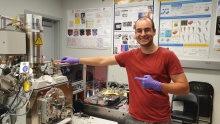
University:
Major:
Mentor(s):
Faculty Sponsor(s):
Faculty Sponsor's Department:
Project Title:
Project Description:
Titanium alloys are widely used in aircraft turbines in the low temperature sections ranging from room temperature to a few hundred degrees Celsius. In this application titanium parts have to be designed to withstand thousands of flights with hours long cruises. One flight corresponds to one cycle of fatigue loading with a peak stress hold for the cruise. Fatigue behavior of titanium alloys at these temperatures differs from other metals. Sustaining the peak stress for minutes to hours during a fatigue test reduces the lifetime by an order of magnitude. This reduction is termed “the dwell debit”. This debit has been blamed for a recent uncontained engine failure at Air France Flight 066 in 2017. Understanding crack initiation and propagation under dwell fatigue helps to predict part lifetime more accurately and to determine optimal service intervals with the goals of reducing maintenance costs while avoiding engine failure.
Experimental examination of dwell fatigue cracking on a microstructural level is highly demanding due to sub-surface fatigue crack growth. Therefore, the collection of both grain orientations and crack positions can only performed by 3D tomography. This research uses TriBeam tomography to collect datasets of titanium samples tested to failure in dwell fatigue, reconstruct the microstructure and cracks, and simulate grain-scale local stress states using linear elastic finite element analysis. By comparison of the crack locations to the surrounding grain neighborhood and resulting stress and strain concentrations, it is possible to assign certain mechanisms or factors promoting crack initiation and growth during dwell fatigue. Literature expects a large influence of grain neighborhood and grain orientation on the location of dwell crack initiation sites, but this could not be confirmed in this research. The only significant influence found in the dataset was a correlation of grain size and crack location.
